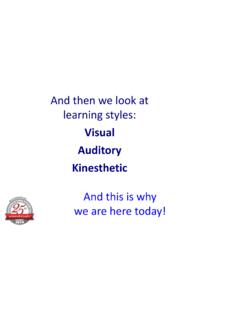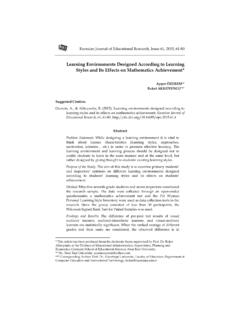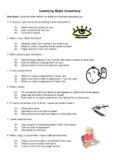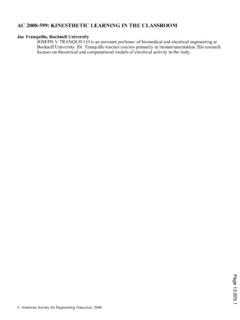Transcription of Learning styles and teaching styles determine students ...
1 International Journal of Evaluation and Research in Education (IJERE). Vol. 8, No. 3, September 2019, pp. 610~615. ISSN: 2252-8822, DOI: 20345 610. Learning styles and teaching styles determine students '. academic performances Nithya Dewi Subramaniam Chetty1, Lina Handayani2, Noor Azida Sahabudin3, Zuraina Ali4, Norhasyimah Hamzah5, Nur Shamsiah Abdul Rahman6, Shahreen Kasim7. 1,3,6 Faculty of Computing, Universiti Malaysia Pahang, Malaysia 2 Faculty of Public Health, Universitas Ahmad Dahlan, Indonesia 4 Department of English, Centre for Modern Languages & Human Sciences, Universiti Malaysia Pahang, Malaysia 5 Faculty of Technical and Vocational Education, Universiti Tun Hussein Onn Malaysia, Malaysia 7 Faculty of Computer Science & Information Technology, Universiti Tun Hussein Onn Malaysia, Malaysia Article Info ABSTRACT. Article history: Individuals learn in different ways using several Learning styles , but lecturers may not always share material and Learning experiences that match students '.
2 Received Oct 2, 2019 Learning preferences. Mismatches between Learning and teaching styles can Revised Nov 13 , 2019 lead to disappointment with students are taking, and lead to Accepted Nov 30, 2019 underperformance among them. The aim of this study is to identify the Learning styles of the students enrolled in Universiti Malaysia Pahang who were registered in Programming Technique course and to investigate the Keywords: relationship between students ' Learning styles and teachers' teaching styles . Five lecturers and 251 students were involved in the study as participants Academic performance and. Data from students were collected using Leonard, Enid's VAK Learning Learning style preference Style Survey. Meanwhile, the teaching styles of the lecturers were identified students using Grasha and Reichmann's teaching Style Survey. The findings revealed teaching style preference that majority of the student's preferred visual Learning style. The result also shows that the lecturers' teaching styles give an impact towards the students ' academic performance.
3 From this study, we can conclude that teaching styles have significant impacts on students ' Learning styles and academic performances. Copyright 2019 Institute of Advanced Engineering and Science. All rights reserved. Corresponding Author: Noor Azida Sahabudin, Faculty of Computing, Universiti Malaysia Pahang, 26600 Pekan, Pahang, Malaysia. Email: 1. INTRODUCTION. teaching and Learning styles play a crucial role in this academic world. Diverse styles of teaching and Learning occur due to the reaction among students in relation to the teaching styles that are demonstrated by the lecturers. This chain-reaction affects the students ' Learning styles preferences [1]. In addition, the diversity in teaching and Learning styles preferences would result in matches and mismatches between the lecturers' teaching styles and students ' Learning styles . According [2] Learning style refers to students ' preferred Learning approaches for all Learning situations while teaching styles refer to the lecturers' behavior, beliefs and selected instructional methods used to present lessons to students [2, 3, 24].
4 Currently, they are many research that are conducted on the concepts of students ' Learning style and educators' teaching style [4, 5]. In addition, students ' Learning styles reflect genetic coding, personality development, and environmental adaptations [6]. Research shows that students gain more knowledge, retain more information and perform better when the teachers' Learning styles match with the students ' Learning styles [7]. However, Journal homepage: Int J Eval & Res Educ. ISSN: 2252-8822 611. According to Gilakjani, one of the weaknesses of the research in Learning style is the lack of investigation concerning the matching of teaching and Learning styles [8]. Due to this gap, the current study, therefore, aims at matching the students ' Learning styles and the lecturers' teaching styles . In other words, this study is conducted with the objective to examine the relationship between students ' Learning styles and lecturers' teaching styles . Also, the research evaluates the impact of teaching style toward students '.
5 Academic performances. 2. LITERATURE REVIEW. In general psychology, the term Learning styles refers to learners' favoured approach to Learning , which includes the process of receiving, collecting, processing, and interpreting to become knowledgeable [9, 10, 25]. A general principle, educational and management approaches are considered as teaching style for a classroom instruction - how an educator imparts knowledge to their students [11]. Some researchers suggest that Learning styles and teaching styles should be well matched in order to enhance students ' motivation of Learning [12, 13, 26]. Research done by [14] found that there was a positive relationship between self-efficacy and teachers teaching thinking practices whereas there was a negative relationship between personal model teaching style and teaching thinking skills. A different study conducted by [15] on the analysis of Learning styles prevalent among secondary school students also tried to find the relationship and effect of different Learning styles on academic achievements of students .
6 Findings of the study revealed that, kinesthetic Learning style was more prevalent than visual and auditory Learning styles among secondary school students . Angela investigated a match or mismatch between Learning and teaching styles in Science education among 179 students and 50 lecturers from Faculty of Science, Sana'a University, Yemen. According to the results, it showed that kinesthetic Learning mode preference was reported as the major Learning style among the students while visual and auditory Learning style were as the minor Learning styles demonstrated by them. Thus, the findings revealed that there is a mismatch between the Learning style and teaching styles [16]. Meanwhile, a study conducted by [17] was find out the impact of teaching and Learning style preferences and their match/mismatch on learners' achievement among 310 English Major students and four (4) lecturers from the Foreign Languages Faculty of Azad University, Iran. The results of the study revealed that matching teaching and Learning styles in EFL classes helped to improve students ' achievement [17].
7 A study conducted by [18] was examine the effect of the match between the Learning and teaching styles of Teachers on students ' Achievement among 700 students and 31 teachers. The results of this study revealed that teachers created the Learning surroundings depending on their own Learning styles and that there has been a close relationship between teachers' Learning styles , students ' Learning styles and students '. achievements in mathematics classes, that students ' achievements increased when teaching is done based on their Learning styles . Besides that, the study revealed that there was a significant relationship between teachers' teaching style and students ' Learning style and students ' academic achievements if they match with one another Learning style [18]. The result obtained with this study has parallelism with those of some other studies in the literature [19-21]. Having to discuss studies concerning Learning styles and teaching styles , it is evident that the issue of matching teaching styles and Learning styles is controversial and the topic needs for more thorough research.
8 It can be concluded that an effective teacher needs to have a resource bank of different teaching methods and activities to draw on from time to time so that maximum can be facilitated [22]. 3. METHOD. The quantitative research approach includes the collection and analysis of numerical data to describe and generalize conditions, investigate relationships, and study the cause-effect of phenomena. The sample for this study was 251 undergraduates' students from Faculty of Computing, UMP who have taken the Programming Techniques subject and five lecturers. To investigate the Learning styles of the students , questionnaires were distributed to the students via online (Google Forms). The questionnaire was constructed based on VAK Learning styles Questionnaire (LSQ); adopted from Leonard, Enid. College Success Simplified, 2005. It consists of three styles assessed by 30 items, 10 items for each style. Each item requires the student to answer Yes or No. The highest score indicates the students ' preference.
9 The lowest score indicates weakest modality. If all three scores are identical, the students have truly integrated all three modalities and can work equally well in any of the modalities. The teaching Style Survey (TSS) by Grasha-Riechmann is an instruments that was employed in this study. TSS questionnaire contains 40 questions in five sections that include the questions of Expert method Learning styles and teaching styles determine students ' academic (Nithya Dewi Subramaniam Chetty). 612 ISSN: 2252-8822. (8 items), Formal authority (8 items), Personal model (8 items), Facilitator (8 items) and Delegator (8 items). Likert scales statements are used to range students ' preferences of an item in the questionnaire in that the scales range from completely agree to completely disagree. The questions have ranked from 1 (extremely disagree) to 5 (extremely agree). The total score of each segment was partitioned to 8 as per the questionnaire index in each teaching method. The main data sources of the proposed study are from questionnaire results and from students '.
10 Academic performance. The questionnaire data was analyzed quantitatively. Statistical Package for the Social Sciences (SPSS) Version was used to analyze students ' responses towards the Learning style preferences questionnaire and teachers' responses towards the teaching style preference questionnaire. In this study, there are two type of datum which are called nominal data and ordinal data. A profile of results was established for each participant. The frequency distribution of questionnaire results was examined. The means for each item were calculated and items with higher use were identified. The standard of p <.05 was used to determine the statistical significance of results. 4. RESULT AND DISCUSSION. The respondents were asked to answer the questions listed in VAK LSQ. The three (3) Learning styles were tested in VAK LSQ include: Visual (V), Auditory (A) and Kinaesthetic (K). Highest score in a given dimension would mean that the student prefers that particular Learning style.















